The Orion Award for Excellence in Experiential Education
 The Orion Award for Excellence in Experiential Education was introduced in 2005 in honor of the Museum’s 75th Anniversary. Named for one of the most familiar constellations–the Hunter Orion, son of the sea god Poseidon–Orion has often marked the course for many seagoing vessels. This annual award recognizes stellar teachers who are inspiring to their students and to their colleagues. Teachers who are willing to take chances, to take full advantage of the resources that are available to them, to be creative and to be ready to turn an unexpected moment into a spectacular teaching opportunity. And, perhaps most importantly, teachers who radiate the joy of learning, as well as of teaching.
Each year, Mystic Seaport Museum celebrates one or more teachers for their commitment in utilizing the Museum’s collections, programs and learning resources to create meaningful and innovative learning experiences for their students. The Orion Award recognizes teachers who infuse history, math, science and literature with a maritime focus. Teachers who use museum resources to illuminate history, and create a living record that reflects America’s present and future as well as its past. Through the Orion Award, Mystic Seaport Museum acknowledges the unique skills and abilities of teachers to link disciplines and communicate ideas with their students, helping their students navigate the course of life.
The Orion Award for Excellence in Experiential Education was introduced in 2005 in honor of the Museum’s 75th Anniversary. Named for one of the most familiar constellations–the Hunter Orion, son of the sea god Poseidon–Orion has often marked the course for many seagoing vessels. This annual award recognizes stellar teachers who are inspiring to their students and to their colleagues. Teachers who are willing to take chances, to take full advantage of the resources that are available to them, to be creative and to be ready to turn an unexpected moment into a spectacular teaching opportunity. And, perhaps most importantly, teachers who radiate the joy of learning, as well as of teaching.
Each year, Mystic Seaport Museum celebrates one or more teachers for their commitment in utilizing the Museum’s collections, programs and learning resources to create meaningful and innovative learning experiences for their students. The Orion Award recognizes teachers who infuse history, math, science and literature with a maritime focus. Teachers who use museum resources to illuminate history, and create a living record that reflects America’s present and future as well as its past. Through the Orion Award, Mystic Seaport Museum acknowledges the unique skills and abilities of teachers to link disciplines and communicate ideas with their students, helping their students navigate the course of life. Award Recipients
Mystic Seaport Museum has named Deidre Toole from Stonington High School the recipient of the 2019 Orion Award.
The Orion Award recognizes teachers who use the resources of Mystic Seaport Museum to illuminate history, and create a living record that reflects America’s present and future as well as its past. This annual award recognizes stellar teachers who are inspiring to their students and to their colleagues. And, perhaps most importantly, teachers who radiate the joy of learning, as well as of teaching. It is named for one of the most familiar constellations — the Hunter Orion, son of the sea god Poseidon — which has often marked the course for seagoing vessels.
Toole, the Transition Counselor and Work Study/Community Classroom Coordinator, has been a teacher in the Stonington Public Schools since 1985. She has taught regular and special education in the elementary and middle schools, and for the past decade, Deidre has been at Stonington High School.
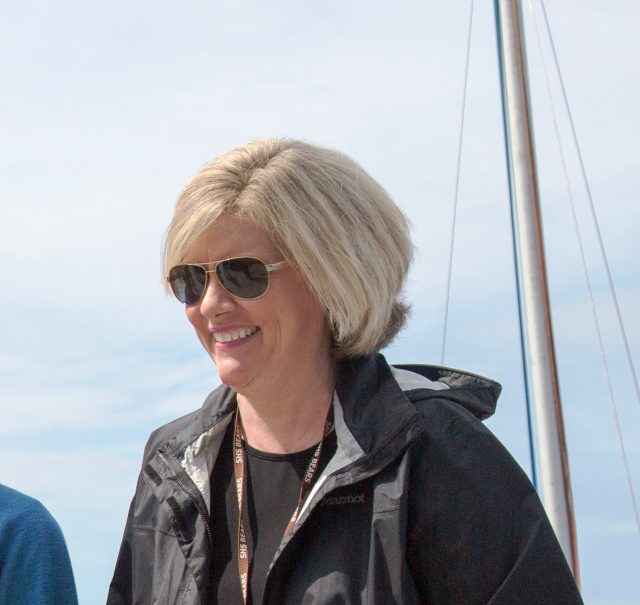 She and her husband have raised three sons in Stonington. They have cherished memories of them growing up on the Museum grounds, which she calls a “piece of heaven.” Toole was the Stonington Public School “Teacher of the Year” in 2007 and was recently awarded the Rotary Club of the Stonington’s “Nancy Zabinski Young Award” and named a “Paul Harris Fellow” by the Rotary Foundation of Rotary International.
She and her husband have raised three sons in Stonington. They have cherished memories of them growing up on the Museum grounds, which she calls a “piece of heaven.” Toole was the Stonington Public School “Teacher of the Year” in 2007 and was recently awarded the Rotary Club of the Stonington’s “Nancy Zabinski Young Award” and named a “Paul Harris Fellow” by the Rotary Foundation of Rotary International.
“Deidre has a passion for finding ways for individuals with disabilities to be meaningful members of the community, ” said Sarah Cahill, director of museum education and outreach. “It was Deidre’s vision to partner with Mystic Seaport Museum staff a few years ago to develop a program for the Community Classroom students to help them enhance life, social, and work skills. The program pairs students with Interpreters in exhibits to learn how best to interact with and engage visitors, and to learn about the exhibit. Students have worked in the Shipsmith, Cooperage, Print Shop, Buckingham Hall House, and on the Demonstration Squad.”
Cahill went on to note that the success of that program led to a discussion between Toole and Museum staff about the need for more engaging afterschool programs. The Education Department worked with Deidre to develop a pilot afterschool boatbuilding program this year. Four students built and successfully launched a Bevin skiff while learning about woodworking, boat design, and teamwork.
“Deidre is an absolute joy to work with, and she clearly cares deeply about each and every one of her students,” Cahill added. “She has such a positive and optimistic attitude, and is always flexible and willing to try new things. She is also very organized and ensures that every student is prepared for success with their time at Mystic Seaport Museum. It is an honor to bestow Deidre with this year’s Orion Award for her dedication to making students’ lives better.”
The award was given Saturday, May 18, during the Museum’s Annual Meeting.
The Bennie Dover Jackson Middle School Writing Stem to Stern Team in New London, CT, is the 2018 recipient of the Orion Award.

Named for one of the most familiar constellations – the Hunter Orion, son of the sea god Poseidon – Orion has often marked the course for many seagoing vessels. The Orion Award recognizes teachers who use the resources of Mystic Seaport Museum to illuminate history, and create a living record that reflects America’s present and future as well as its past. This annual award recognizes stellar teachers who are inspiring to their students and to their colleagues. And, perhaps most importantly, teachers who radiate the joy of learning, as well as of teaching.
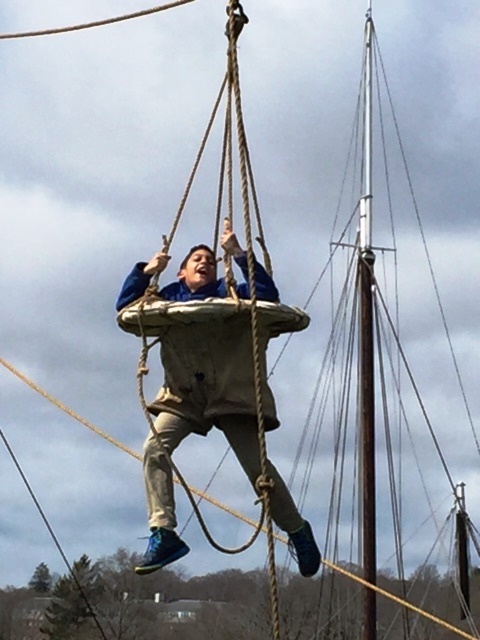 We are currently in the second year of a three-year program called Writing Stem to Stern, a program inspired by renowned author Nathaniel Philbrick that helps teach students at Bennie Dover Jackson Middle School to become better writers and communicators about our nation’s maritime history. Each year students participate in immersive experiences and interact with Mystic Seaport’s artifacts and primary source materials that serve as visceral prompts for writing and broadens their knowledge of the maritime history of their city.
We are currently in the second year of a three-year program called Writing Stem to Stern, a program inspired by renowned author Nathaniel Philbrick that helps teach students at Bennie Dover Jackson Middle School to become better writers and communicators about our nation’s maritime history. Each year students participate in immersive experiences and interact with Mystic Seaport’s artifacts and primary source materials that serve as visceral prompts for writing and broadens their knowledge of the maritime history of their city.
Activities the students have experienced include participating in a 19th century rescue technique used for shipwrecks, chantey programs, guided tours, team building activities, rope-making, virtual programs, primary source workshops, making scrimshaw, climbing the rigging of the Joseph Conrad, Planetarium program, whaleboat rowing, and more. The program will culminate with a writing project that will be presented by the students to the Mystic Seaport Board of Trustees, Nathaniel Philbrick, the New London Board of Education, and for posting on the Mystic Seaport Museum for Educators website.
The Writing Stem to Stern program is integrated into Bennie Dover Jackson’s Leadership Education and Development Program (L.E.A.D.). The objective of L.E.A.D. is to “foster students’ independence, teach responsibility, organization and critical thinking skills. Students will experience challenge, choice, and collaboration as a foundation for their growth and development as a Leadership Student.” Dr. Burdick and her team here today radiate passion for teaching and empowering students to become all that they can. We have seen firsthand how they tirelessly strive to provide the most engaging experiences for their students. They care so deeply about each and every student and are clearly making a difference in their lives. That is precisely why it is such an honor to bestow this year’s Orion Award to this wonderful team of teachers and administrators:
- Dr. Alison Burdick, Director of Leadership, Language, and Culture
- Ed Sweeney, Director of Athletics
- Amanda Illinger, LEAD Field Experience Teacher
- Erin Arzamarski, Social Studies teacher (and New London Teacher of the Year!)

Mystic Seaport has named the teachers of the Navigator Program at Hamden Middle School in Hamden, CT the recipients of the 2017 Orion Award. Those teachers are: Andrew Marzano, 8th grade science, Tara Riley, 8th grade English, Nicholas (Nick) Ugolik, 8th grade social studies, and Robert (Rob) Mandel, 8th grade math.
Named for one of the most familiar constellations — the Hunter Orion, son of the sea god Poseidon — Orion has often marked the course for many seagoing vessels. The Orion Award recognizes teachers who use the resources of Mystic Seaport to illuminate history, and create a living record that reflects America’s present and future as well as its past. This annual award recognizes stellar teachers who are inspiring to their students and to their colleagues. And, perhaps most importantly, teachers who radiate the joy of learning, as well as of teaching.
The Navigator Program serves 8th grade students at Hamden Middle School who have not thrived in a traditional classroom setting. It is a multi-disciplinary program that integrates math, science, English, social studies, woodworking, and character building to support the public school curriculum. The educational experiences that this program provides enrich students’ lives at the social, emotional and academic levels. Because the choices made by teenagers set the direction for their future, the goal of the Navigator Program is to help students gain the practical and relevant life experiences today, rather than at some indeterminate time in their future. The Navigator Program helps these struggling students to develop the hard and soft skills so that each one of them may seek opportunities for success and accomplishment in their future endeavors.
Andrew Marzano, the 8th grade science teacher and visionary behind the program, approached Mystic Seaport in 2012 about building this type of program. As a teacher at Hamden Middle School, Andrew realized that boatbuilding was an ideal way to get his summer school students to learn the math and science concepts they didn’t absorb during the school year. So in 2011, he did just that. The project went so well, they built another boat the next summer, and another the summer after that. Around the same time, Andrew and his colleague Rob Mandel began to discuss a more in-depth program for underserved eighth graders—those who had consistently low grades or high rates of absenteeism. They wanted to create an environment for these students that would channel their energy and give them a way to succeed outside of a traditional classroom setting.
The Navigator Program uses boatbuilding as the central theme because it is an effective way to teach math and science, and given Connecticut’s historic connection to the sea, it was easy to integrate boatbuilding alongside a study of maritime history and literature. Hoping to give students the tools to steer themselves through life’s sometimes stormy waters, Andrew and Rob dubbed it The Navigator Program. Andrew worked tirelessly with school Principal Dan Levy, and Superintendent Jody Goeler to get the program and budget approved.
Students participate in a variety of programming at Mystic Seaport that are designed to complement what they are doing in the classroom. This includes an overnight program while sleeping on the historic vessel Joseph Conrad, work as apprentices with our master craftsmen to complete in-depth projects, and actually sail our 61-foot schooner Brilliant together. Back at Hamden Middle School, in addition to completing their normal coursework in each subject, they also build boats right at their school.
Andrew, Tara, Rob, and Nick are all stellar educators who care deeply about each and every student. We have seen first-hand how much of themselves they pour into this program because they truly want these students to succeed. Too often students who have had a rough time of it in their lives are overlooked in school or punished. The Navigator team wanted to create another way that actually provides hands-on, fun, and meaningful learning for students that engage them and hopefully keeps their interest in school.
Andrew and his team have started to see positive results of the program. One student in the Navigator program missed only four days of school this year, compared to 100 last year. One student wrote: “I am not the same [student] as the first day of school. I feel if I [wasn’t in the Navigator program] my grades would not be as good and I would not get the extra push the Navigator teachers gave me.” Another student said “Throughout the mid-school year I have become a better person academically and in general too.” Yet another student in the program wrote: “I kind of think of the Navigator Program as a program for second chances. People were already giving up on us, except for Mr. Marzano, Mrs. Riley, Mr. Mandel, and Mr. Ugolik.”
That is precisely why it is such an honor to bestow this year’s Orion Award to the Navigator Program teachers. They have not given up on these students, and they creatively use our resources at Mystic Seaport to enhance the program.
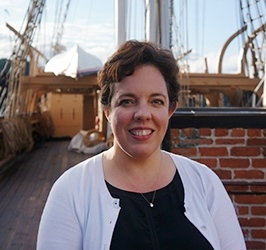 Mystic Seaport has named Laura J. Krenicki from the William J. Johnson Middle School in Colchester the recipient of the 2016 Orion Award.
Mystic Seaport has named Laura J. Krenicki from the William J. Johnson Middle School in Colchester the recipient of the 2016 Orion Award.
The Orion Award recognizes teachers who use the resources of Mystic Seaport to illuminate history, and create a living record that reflects America’s present and future as well as its past. This annual award recognizes stellar teachers who are inspiring to their students and to their colleagues. And, perhaps most importantly, teachers who radiate the joy of learning, as well as of teaching. It is named for one of the most familiar constellations — the Hunter Orion, son of the sea god Poseidon — which has often marked the course for seagoing vessels.
Krenicki has been teaching 6th grade for thirteen years, and is an inspiration to her students as well as other teachers. Shwe has worked closely with the Mystic Seaport Education Department staff here to create innovative field trips for her students that truly capitalize on all the Museum has to offer.
She has also been a Mystic Seaport for Educators (MSE) Fellow for the past two summers, and has created excellent content for the MSE website that showcases the primary sources in our collection. As a Fellow, . Krenicki has worked on several projects, including the Indian Mariners Project, a collaboration between multiple institutions and individuals that explores the history of and ongoing relationship between Native peoples and the sea. While researching for this project. Krenicki learned about the international connections the whaling industry provided between local people and cultures as far away as New Zealand. Her students began to investigate some of these connections, and partnered with a school in New Zealand. To continue this relationship and to make connections with descendants of local Connecticut mariners. Krenicki was awarded a Fund for Teachers Fellowship to travel to several sites in New Zealand in 2017 to continue the research.
Krenicki is not content to “just” change the lives of her students; she is also passionate about being a mentor and teacher to other teachers as well. She teaches a class of aspiring elementary school teachers at Eastern Connecticut State University as well as the University of New Haven. A National Geographic Certified Teacher and the professional development chair for the Connecticut Geographic Alliance, Krenicki has worked with teachers around the state on professional development programs in geography and social studies. She was also one of the authors of the Social Studies Frameworks for Connecticut, and was appointed a Board member of the Connecticut Council for the Social Studies.
Krenicki was recently named the recipient of the Excellence in Social Studies Education award by the Connecticut Council of Social Studies for the state of Connecticut, and has also been recognized as one of the Connecticut Teacher of the Year semi-finalists in her district in 2005.
“As impressive as all these accolades are, even more important is the amazing energy and spirit that Laura brings to her classroom, and to every project she works on,” said Sarah Cahill, the director of education at Mystic Seaport. “She is a creative thinker and is constantly thinking of ways to improve teaching and learning. We are proud to work with Laura, and her students are lucky to have her.”
Operations Manager for Winthrop STEM Elementary Magnet School in New London, CT
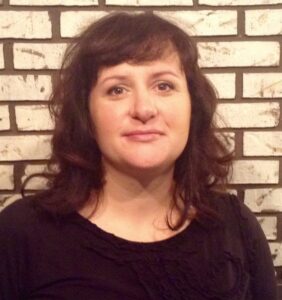 Mystic Seaport has named Angela McGhee from Winthrop STEM Elementary Magnet School in New London the recipient of the 2015 Orion Award.
Mystic Seaport has named Angela McGhee from Winthrop STEM Elementary Magnet School in New London the recipient of the 2015 Orion Award.
The Orion Award is bestowed by Mystic Seaport on teachers who create meaningful and innovative learning experiences for their students by utilizing the Museum’s collections, programs, and learning resources. The Award recognizes teachers who infuse history, math, science, and literature with a maritime focus and are an inspiration to their students and their colleagues.
The Museum has given the award annual since 2005.
As the Operations Manager for Winthrop STEM (Science, Technology, Engineering and Math) Elementary Magnet School, McGhee’s primary responsibility is to oversee the Expanded Learning Time program. Expanded Learning Time is a national initiative designed to give students the opportunity for more quality time within the school day to experience a variety of enriching and engaging experiences. The program at Winthrop has added 300 hours to the regular school for students with help from teachers and community partners like the Mystic Seaport.
Students have the opportunity to develop deeper learning skills such as teamwork, public speaking, and creative problem solving. Under Angela’s leadership, Mystic Seaport provided 92 sessions of Expanded Learning Time programs for the school’s 4th grade students over the course of 18 weeks. The programming connects to Winthrop’s focus on STEM and vocabulary development, while exploring topics that included astronomy, whaling, life in a seaport town, and the use of primary sources.
“Angela has a wonderful combination of being able to “think big” and then implement the visionary idea,” said Sarah Cahill, the director of education at Mystic Seaport. “Angela truly understands the value of experiential learning, and has worked hard to forge lasting relationships with Mystic Seaport and other community partners to provide the most engaging and impactful education to the students at Winthrop.”
Dean of Student Affairs and Teacher at The Williams School in New London, CT
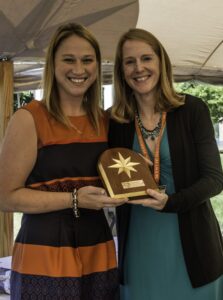 Macy Kleinfelder, the Dean of Student Affairs and a history teacher at The Williams School in New London, Connecticut, is the 2014 recipient of the Orion Award for Excellence in Experiential Education. Kleinfelder received the Award at the annual Members Meeting at Mystic Seaport on Saturday, September 27.
Macy Kleinfelder, the Dean of Student Affairs and a history teacher at The Williams School in New London, Connecticut, is the 2014 recipient of the Orion Award for Excellence in Experiential Education. Kleinfelder received the Award at the annual Members Meeting at Mystic Seaport on Saturday, September 27.
The Orion Award is bestowed by Mystic Seaport on stellar teachers who create meaningful and innovative learning experiences for their students by utilizing the Museum’s collections, programs, and learning resources. The Award recognizes teachers who infuse history, math, science, and literature with a maritime focus and are an inspiration to their students and their colleagues.
In the summer of 2012, Kleinfelder was selected as one of a group of teachers to help Mystic Seaport create an online learning community for educators. This has since developed into Mystic Seaport for Educators (MSE), an innovative website for teachers that facilitates access to the Museum’s collections for the purpose of creating learning tools to bring America’s maritime heritage into the classroom.
As an MSE Fellow, Kleinfelder conducted extensive research at Mystic Seaport and wrote Artifact Articles for the website about a gamming chair, Chinese slippers, and a War of 1812 sea bag. She used this experience and new knowledge to create a mid-term project where her students delved deeper into the War of 1812 and gained a better understanding of artifacts of the period.
Kleinfelder also brought her students to Mystic Seaport to analyze the 1841 whaleship Charles W. Morgan as an artifact, and completed a “Curators’ Challenge” with her students and Museum staff, where they had to create an exhibit based on artifact analysis. She used this trip to prepare her students for an inquiry-based mid-term project back in the classroom. She also worked with Mystic Seaport staff to create an online map of the 27th voyage of the Morgan using the ship’s logbook. For this project, Kleinfelder created a Williams School Whaling Project blog.
Additionally, Kleinfelder taught a professional development workshop for museum educators at Mystic Seaport about working with middle- and high-school students.
“We chose to honor Macy Kleinfelder with this award because she is a treasure trove of new ideas, and she is willing to take risks in the classroom, try new approaches, and constantly pursue innovation and improvement,” said Sarah Cahill, director of Education at Mystic Seaport.
Kleinfelder attended the Peddie School in Hightstown, New Jersey, and the University of St. Andrews. Shortly after graduating with an MA from St. Andrews, she began teaching. Over the past four years, Kleinfelder has taught middle school Geography and English, US History, Modern World History, Reel History (history and film), Economics, and The History of the Sixties. In her free time, she performs in community theater and coaches the Williams School field hockey team.
Teacher at Hamden Hall Country Day School in Hamden, CT
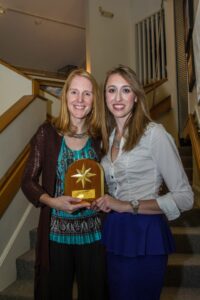 Emily Schimelman of Middletown, CT has been named the 2013 recipient of the Mystic Seaport Orion Award for Excellence in Experiential Education. She was honored at a reception at the Museum’s Maritime Gallery on September 27.
Emily Schimelman of Middletown, CT has been named the 2013 recipient of the Mystic Seaport Orion Award for Excellence in Experiential Education. She was honored at a reception at the Museum’s Maritime Gallery on September 27.
The Award is bestowed annually by Mystic Seaport on educators who create meaningful and innovative learning experiences for their students by utilizing the Museum’s collections, programs, and learning resources. The Orion Award recognizes teachers who infuse history, math, science, and literature with a maritime focus and are an inspiration to their students and their colleagues.
Schimelman is a fourth grade teacher at Hamden Hall Country Day School in Hamden, CT. She teaches reading, language arts, and specializes in social studies. With the help of Mystic Seaport staff, she created a year-long unit on American whaling, life at sea, and the 1841 whaleship Charles W. Morgan. The hands-on, project-based unit focuses on artifacts, primary sources, artwork, music, acting, journal writing, and critical thinking to inspire lifelong learning through exploration.
Schimelman also masterminded the creation of a Mystic Festival at Hamden Hall, where students created 12 booths representing primary aspects of the whaling unit. Students collaborated in small groups where they researched their topic and created the content and activities for their station. Participants were given 15 minutes at each booth before they rotated to the next.
As the point person for a new partnership between Mystic Seaport and Hamden Hall, Schimelman has fostered a constructive relationship of program development and evaluation for both institutions. She is also contributing to the creation of Mystic Seaport for Educators, an online learning community that will use historic artifacts in the Museum’s collections to build interactive learning tools for educators and students. Mystic Seaport for Educators is a key component of the Museum’s “Year of the Charles W. Morgan” in Connecticut, a series of learning tools and programs that utilize the ship and her 2014 38th Voyage to teach a range of subject material, including but not limited to history.
“We chose to honor Emily Schimelman with this Award because she understands that primary sources and hands-on research are more than just a fun experience—they create an opportunity for students to develop and apply critical thinking and problem-solving skills, which are integral components of the new Common Core State Standards being implemented in schools today,” said Sarah Cahill, director of Education at Mystic Seaport.
Teacher at the Charles Morgan School in Clinton, CT
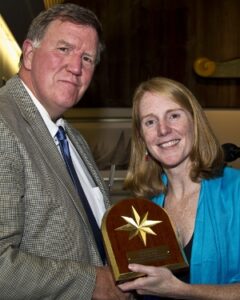 Michael Graham, a history and civics teacher at the Charles Morgan School in Clinton, Connecticut, has been awarded the 2012 Mystic Seaport Orion Award for Excellence in Experiential Education. He was honored at the Museum’s annual donor recognition dinner on September 28.
Michael Graham, a history and civics teacher at the Charles Morgan School in Clinton, Connecticut, has been awarded the 2012 Mystic Seaport Orion Award for Excellence in Experiential Education. He was honored at the Museum’s annual donor recognition dinner on September 28.
The Orion Award is bestowed by Mystic Seaport on stellar teachers who create meaningful and innovative learning experiences for their students by utilizing the Museum’s collections, programs, and learning resources. The Award recognizes teachers who infuse history, math, science and literature with a maritime focus and are an inspiration to their students and their colleagues.
Graham has been a key collaborator in the development of the Mystic Seaport “Adventures in Research” experiential education program, where students are introduced to primary source material from the Museum’s collections and asked to explore important themes around whaling and the 1841 whaleship Charles W. Morgan. Students are tasked to come up with essential questions about each of the themes and develop a draft research strategy for researching and uncovering clues about those themes and how they each tell important parts of the story of the Morgan. The goal is to stimulate critical thinking skills and to encourage participants to become “historian detectives.” The program will be a component of the state’s 2013-2014 “Year of the Charles W. Morgan,” in which Connecticut schools will be provided learning resources to utilize the ship as an educational tool across multiple disciplines.
In addition to his role in the “Adventures in Research” program, Graham also presented at this year’s Mystic Seaport Summer Teacher Institute. The Institute brought teachers from across the country to learn methods for students to research and use inquiry methods using primary source material.
“‘We chose to honor Michael Graham with this award because he understands that primary sources and hands-on research create an opportunity for students to develop and apply critical thinking and problem-solving skills, which are integral components of the new Common Core standards being implemented in schools today,” said Sarah Cahill, Director of Education at Mystic Seaport.
A lifelong learner, Graham continually adds to his repertoire through experiential learning. He has been a participant in Yale University’s PIER Institute Summer Programs, a participant in Gilder Lehrman Institute and actively uses the Brown University Choices Program.
During his teaching career in three school districts, and as a trainer and supervisor in private business, he continuously applied the principles learned in education to the training he provided in business operations. Graham has been a successful coach in athletics, a tutor, serves on several high school committees and is involved with the Connecticut Geographic Alliance.
Graham said, “The use of primary sources and the experience of hands-on research are more than just a fun experience–they create a real experience that allow the students to develop the Common Core standards our schools want students to learn and use. The Mystic Seaport Research Program is an example of collaboration between public and private that provide students new methods of learning with impact for the rest of their lives.”
The Charles Morgan School is named after Charles Morgan, an influential 19th-century shipping and railroad businessman from Clinton. He is no relation to the New Bedford whaling merchant Charles W. Morgan, namesake of the Museum’s whaleship.
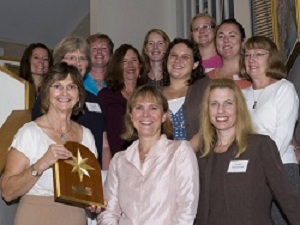 This year’s Orion Award was presented to the entire staff and faculty of West Broad St. School in Pawcatuck, CT during the reception for the donor recognition dinner on September 23.
This year’s Orion Award was presented to the entire staff and faculty of West Broad St. School in Pawcatuck, CT during the reception for the donor recognition dinner on September 23.
Terry Jordan, the principal, and her entire team at West Broad St. School deserve this Orion Award because of the creativity and courage they have demonstrated by integrating Mystic Seaport’s educational resources into their classroom. They have a vision of creating a “Seaport School” as a Center of Excellence, where their curriculum is fully intertwined with and supported by our resources here at Mystic Seaport. As part of this vision, all students at West Broad St. School have the opportunity to experience Mystic Seaport in a way that is truly connected to and a part of their curriculum, and more than “just a field trip.” It is an extension of the classroom. Over the course of the entire school year, Museum staff visit the school to do experiential programming in the classroom, then students visit Mystic Seaport for immersive, hands-on experiences that complement and solidify what they have learned in school.
The Orion Award recognizes educators for “their commitment in utilizing the Museum’s collections, programs, and learning resources to create meaningful and innovative learning experiences for their students.” West Broad St. School more than meets these criteria. But it is something else in our description of the Orion Award that really rang true. It states: “And, perhaps most importantly, [this award is for] teachers who radiate the joy of learning, as well as of teaching.” This could not better describe the entire team at West Broad St. School. They are passionate, exuberant, and truly communicate the joy of learning to their students in a way that is inspiring. We are honored to have them as a partner.
East Lyme High School Teacher
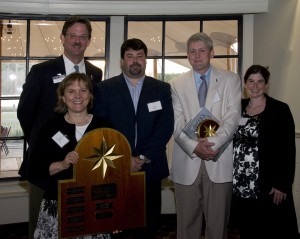 Jason Hine, a Social Studies teacher at East Lyme High School in East Lyme, CT, has been awarded the Mystic Seaport Orion Award for Excellence in Experiential Education. He was honored at an awards dinner May 21.
Jason Hine, a Social Studies teacher at East Lyme High School in East Lyme, CT, has been awarded the Mystic Seaport Orion Award for Excellence in Experiential Education. He was honored at an awards dinner May 21.
Mystic Seaport presents the award each year to a teacher who draws upon the rich array of educational opportunities offered at the Museum to create innovative and experiential classroom lessons.
“Great teachers are like constellations,” said Susan Funk, executive vice president of Mystic Seaport. “They help students navigate by pointing the way, leading them to new lands and then home again, wiser and more experienced.”
At East Lyme High School, Hine has implemented a public history approach in his teaching, bringing students out of the classroom and into the field for first-hand encounters with the places, artifacts and activities that illuminate their classroom studies. Each of Hine’s classes visits Mystic Seaport several times during a semester to study various aspects of maritime history including whaling, fishing and ship construction.
“As a life-long learner, Jason continually adds to his repertoire through experiential learning, as well as research-based study,” said Funk. “To further develop his working knowledge of maritime history and heritage, Jason has worked at Mystic Seaport on the demonstration squad and sailed aboard Niagara and the Amistad. Through his actions and passion, he inspires his students to do the same.”
Hine explored his interest in maritime education as a graduate student in the Liberal Studies Program at Wesleyan University. He wrote his M.A. thesis on fictional and non-fictional accounts of whaling using the Museum’s vast resources–from the Charles W. Morgan to the G.W. Blunt White Library–during his research. As a teacher at East Lyme High School, Hine created the school’s first maritime history course ever offered, and participated in the Munson Institute at Mystic Seaport for several summers prior as further preparation.
East Lyme High School is a four-year comprehensive public high school offering curricular and co-curricular programs to 1,300 students in grades nine through 12. Accredited through the New England Association of Schools and Colleges, the school offers an extensive range of courses in college and career preparation. The school also participates in partnership programs with Connecticut College, the University of Connecticut and Three Rivers Community College. Students also have an opportunity to take virtual courses through the Virtual High School program.
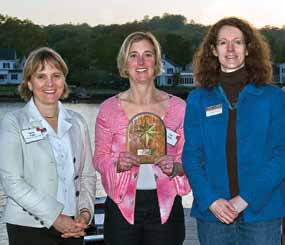 Gay Long, a fifth-grade teacher at Pine Point School in Stonington, CT, is this year’s recipient of the Mystic Seaport Orion Award for Excellence in Experiential Education.
Gay Long, a fifth-grade teacher at Pine Point School in Stonington, CT, is this year’s recipient of the Mystic Seaport Orion Award for Excellence in Experiential Education.
Each year, Mystic Seaport presents the award to a teacher who uses the educational opportunities offered at the Museum to create innovative and experiential classroom lessons.
“Great teachers are like constellations,” said Susan Funk, executive vice president of Mystic Seaport. “They help students navigate by pointing the way, leading them to new lands and then home again, wiser and more experienced.”
In 2007, Long, along with Mystic Seaport Director of Education Lisa Marcinkowski, developed and implemented a six-week apprenticeship immersion program at the Museum. The program, which also serves as the basis for an assessment project at Pine Point School, familiarizes students with historical trades and research in an interactive environment.
“This program is a testament to the power of hands-on learning, the power of being immersed in a historical environment and the power of informal learning in museums.
“This program has run successfully for two years and we hope it will be a model for other independent-school assessment procedures,” said Marcinkowski. “The apprenticeship program was also one of the inspirations for the Museum’s new immersion program, ‘A Day in 1876,’ that has been designed for public schools. And this is all thanks to one dedicated teacher’s wonderful idea!”
Booth Hill Elementary School in Shelton, CT
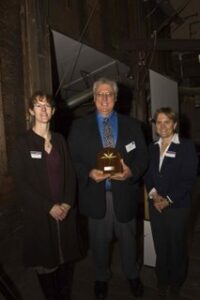 Each year, Mystic Seaport presents the award, to a teacher who draws upon the rich array of educational opportunities offered at Mystic Seaport to create innovative and experiential classroom lessons. William Federowicz, a sixth grade teacher at Booth Hill Elementary School in Shelton, has been named the 2008 recipient of the Mystic Seaport Orion Award for Excellence. Federowicz was honored at an awards dinner in May.
Each year, Mystic Seaport presents the award, to a teacher who draws upon the rich array of educational opportunities offered at Mystic Seaport to create innovative and experiential classroom lessons. William Federowicz, a sixth grade teacher at Booth Hill Elementary School in Shelton, has been named the 2008 recipient of the Mystic Seaport Orion Award for Excellence. Federowicz was honored at an awards dinner in May.
Federowicz, along with fellow teachers Chris Margait and Eileen Moore, has developed and implemented a Mystic Seaport-centered interdisciplinary unit for sixth graders at Booth Hill Elementary. Through the integration of language arts, science, social studies, art, music and physical education, Federowicz brings Connecticut’s coastline to life and shows students how important their impact can be on the ecosystem and their community.
In Federowicz’s classroom, students take an in-depth look at cetaceans and their current role in ocean ecology, as well as examine the historical impact whales have made on New England’s economy. Throughout the school year, students keep a “whale man’s log,” which acquaints students with the unique life of a whaler and also helps students better understand the relationship whaling had with individuals and communities. Students also learn sea shanties, create scrimshaw and reenact period dances.
A year-end field trip to Mystic Seaport is the culminating educational experience in Federowicz’s classroom. Once on Museum grounds, students participate in an historical scavenger hunt which utilizes the instruction and knowledge they have accumulated throughout the school year.
Congratulations, Bill!
Montville High School, Montville, CT
Wendy Halsey, of Montville, CT, has been named the 2007 recipient of the Mystic Seaport Orion Award for Excellence.
This year, through Halsey’s initiative, a new course was introduced at Montville High School, “Maritime Literature.” Halsey created the syllabus that includes the works of Homer, Joseph Conrad and Patrick O’Brien. Field trips, including a visit to Mystic Seaport, were also incorporated into the curriculum. Halsey, through her own generosity, purchased the materials needed to educate her students.
During her teaching career in the Montville school district, Halsey has been the poetry club advisor, a tutor at Mitchell College, served on several Montville High School committees and is involved in the Connecticut Writing Project at the University of Connecticut.
Lyme/Old Lyme Middle School
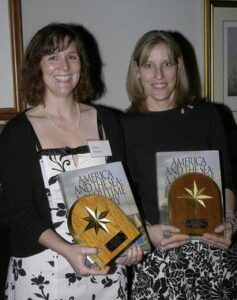 Heather Hug and Olivia Hersant, teachers at Lyme/Old Lyme Middle school were named joint recipients of the Mystic Seaport Orion Award for Excellence in 2006.
Heather Hug and Olivia Hersant, teachers at Lyme/Old Lyme Middle school were named joint recipients of the Mystic Seaport Orion Award for Excellence in 2006.
“The winners and their school have demonstrated leading edge approaches to education utilizing primary sources, innovative techniques and the willingness to explore topics across disciplines,” said Susan Funk, vice president of education and public programs at Mystic Seaport. “As a team, they represent a unique approach to teaching, an approach that underscores that teaching–and learning–is a partnership.”
Hug, who lives in Groton, has taught social studies for three years. Hersant, from New London, has taught language arts for seven years. They have worked together for the last three years, team teaching as much as their schedules allow.
Both teachers participated in the Museum’s Human Tide program, a summer institute that explores the use of primary sources in the classroom, as well as providing opportunities for teachers to learn about working with Museum teachers, researchers, curators and historic roleplayers.
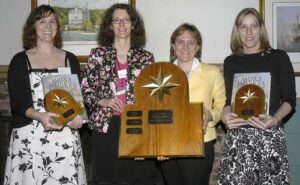 One of the uses Hug and Hersant developed for using primary sources was for the students to develop a class scrapbook and in doing so use their own primary sources to complete the task.
One of the uses Hug and Hersant developed for using primary sources was for the students to develop a class scrapbook and in doing so use their own primary sources to complete the task.
“The use of primary sources and more extensive research does more than just make a project fun–it also makes it real and easier for the students to understand,” Hersant said.
Hug said her experience with the Human Tide program provided both teachers a new appreciation for ways the Museum can be integrated into different elements of their curriculum.
“The program proved to be a great experience for both of us,” she said. “We didn’t realize how much information is available to us. Now that we do, it’s something we’ll no doubt continue to utilize.”
American School for the Deaf
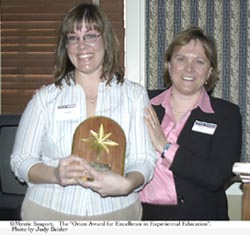 Mystic Seaport is proud to announce the recipient of the 2005 Orion Award is Annie Nutt from the American School for the Deaf in West Hartford, CT. Annie has been a teacher at ASD for almost 20 years, teaching both in the humanities and sciences during the course of her career. She is highly regarded by her colleagues, students, and their families.
Mystic Seaport is proud to announce the recipient of the 2005 Orion Award is Annie Nutt from the American School for the Deaf in West Hartford, CT. Annie has been a teacher at ASD for almost 20 years, teaching both in the humanities and sciences during the course of her career. She is highly regarded by her colleagues, students, and their families.
Annie has taken advantage of the Museum’s summer professional development institute The Human Tide, and the school overnight program Ship to Shore immersing her students in maritime life and culture at Mystic Seaport. She has the unparalleled ability to find “teaching moments” in the most unexpected places extending the lessons learned here not only to the classroom, but also incorporated them–and a bit of luck–into a truly remarkable experience.
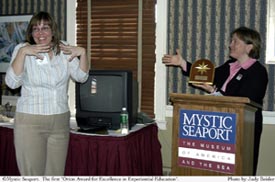 In August 2004, Annie participated in The Human Tide, the Museum’s weeklong summer institute examining American immigration and the sea. Great educators find teaching moments in unexpected places. While trawling Long Island Sound with her students, a wallet emerged from the sea. Annie immediately thought of teaching techniques learned at Mystic Seaport and turned the discovery into an historical investigation. With permission from the owner, Annie’s students used the wallet and its contents to create a portrait of his life. “John Wallet”, as he was affectionately named by the students, became a presence in the American School for the Deaf classroom, serving as an informant in the students’ investigation of his life. It was an unparalleled opportunity for sharpening critical thinking and research skills.
In August 2004, Annie participated in The Human Tide, the Museum’s weeklong summer institute examining American immigration and the sea. Great educators find teaching moments in unexpected places. While trawling Long Island Sound with her students, a wallet emerged from the sea. Annie immediately thought of teaching techniques learned at Mystic Seaport and turned the discovery into an historical investigation. With permission from the owner, Annie’s students used the wallet and its contents to create a portrait of his life. “John Wallet”, as he was affectionately named by the students, became a presence in the American School for the Deaf classroom, serving as an informant in the students’ investigation of his life. It was an unparalleled opportunity for sharpening critical thinking and research skills.


